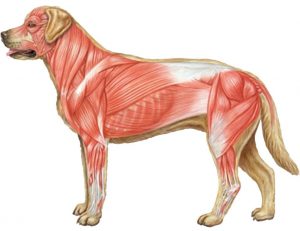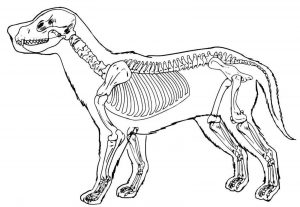Dog massage therapy has discernible effects on the body’s various organ systems. Massage benefits our dogs by helping to keep the organ tissues healthy and promotes healing so that the function and efficiency of the whole body is enhanced.
Because the main body systems do not work in isolation, the benefits of massage on one system will impact others as well. Over the course of the next couple of months, we’ll discuss the the various physiological benefits of dog massage – this edition is all about the muscular and skeletal systems.
A balanced muscular system is important
In order for a body to move effectively, the skeletal muscles must be balanced. This means that the muscles on both the left and right sides of the body should have the same mass, be of equal length and should achieve the same level of efficiency.
An imbalance could be due to injury, disease, or may be due to one set of muscles over-compensating for the reduced function in another set. Overuse can cause muscles to remain in a state of contraction, thus also causing imbalance in the body. Tight muscles will cause posture to be pulled out of alignment. Massage can be an effective way to help to improve muscle tone, balance and posture, thus giving better support to the skeletal system.

The frictional heat produced by massage warms the skin and dilates the blood capillaries. This has the effect of speeding up the blood circulation and combined with an enhanced delivery of fresh arterial blood, provides the muscle cells with additional oxygen and nutrients. Thus accelerated recovery from fatigue and injury will be enhanced.
Enhanced toxin removal aids the healing process
Massage also encourages the removal of toxic waste products due to an enhanced flow of return venous blood to the heart. Working muscles burn oxygen and glucose and produce lactic acid, which can build up in the muscles and cause muscle pain. The more rapid removal of waste products helps to reduce muscle pain, stiffness and tension. Therefore, the healing process is reinforced.
Help with muscular relaxation and prevention of muscle atrophy
Massage helps to increase muscle relaxation, releasing any muscular tension which may be straining ligaments or tendons.
Muscle which is not regularly exercised, (due to injury, age, surgery) will waste away and have a lack of muscle tone (atrophy). Massage can be used as a treatment to prevent or delay muscular atrophy. Furthermore it can improve muscle tone in those who are inactive.
When muscle tissue is damaged, the subsequent bleeding develops into scar tissue, which can harden over time. Friction massage can help to limit scar tissue by breaking it down into smaller particles. These can then be digested by white blood cells and absorbed into the lymph vessels.
Finally, massage can be of benefit to the muscular system by breaking down or preventing adhesions (knots), by relieving cramps and muscle spasms. Massage can also help to decrease muscle swelling and associated pain.
The skeletal and muscular systems work together
The skeletal system works together with the muscular system to provide levers for movement and posture. Therefore, the relationship between the skeletal and muscular systems is very close.
In order for the muscular system to function at its optimum potential, secure joints and muscle attachments are necessary for muscular and skeletal stability. Any weaknesses within the skeletal system can cause imbalance within the muscular system. And vice versa. Massage can improve muscle tone and balance, thus facilitating less stress and better support to the skeletal system.

Frictional stress causing pain can be eased through the application of massage to reduce muscle and tendon tension around the joints. This can help to improve range of movement, mobility and locomotive speed.
Massage benefits joints by helping to improve joint mobility
Furthermore, the application of passive movement as a massage technique, can help with joint mobility and joint lubrication. This is due to the warming up of the synovial fluid within the joint – making it more fluid and less viscous. Passive movement of the joint also causes fresh synovial fluid to be released into it. This helps to lubricate the joint and reduces any friction which may have caused pain. A greater fluidity of movement, brought about by regular massage also decreases the likelihood of suffering muscular injuries.
Massage also helps to relieve stiff and inflamed joints, caused by conditions such as arthritis and tendinitis. These conditions can be treated by massage to loosen and relax neighbouring muscle groups.
The skeletal system also benefits from the stimulated circulation brought upon by massage. The delivery of nutrients to the bones and joints is enhanced, which boosts cellular regeneration and development, i.e. it can assist in the healing of bone fractures, etc.
Sources
- Health Reviser, 2010. The Physical and Mental Benefits of Massage. Available at: http://www.healthreviser.com/content/physical-and-mental-benefits-massage.
- Hingle, L., 2011. Physiological Benefits of Massage. Available at: http://www.livestrong.com/article/34829-physiological-benefits-massage/.
- McGill, S., 2008/9. The Effects of Massage, SR134, Sports Massage, St Mary’s University College, unpublished.
- Natural Therapy Pages, 2013. How Your Body Benefits From Massage. Available at: http://www.naturaltherapypages.co.uk/article/massage_benefits.
- Robertson, J., 2010. The Complete Dog Massage Manual. Dorset: Veloce Publishing Ltd.
- Tree, G., 2011-2012. Benefits of Massage. Available at: http://massagetherapy.co.uk/therapies-information/articles-and-notices/benefits-of-massage/.
